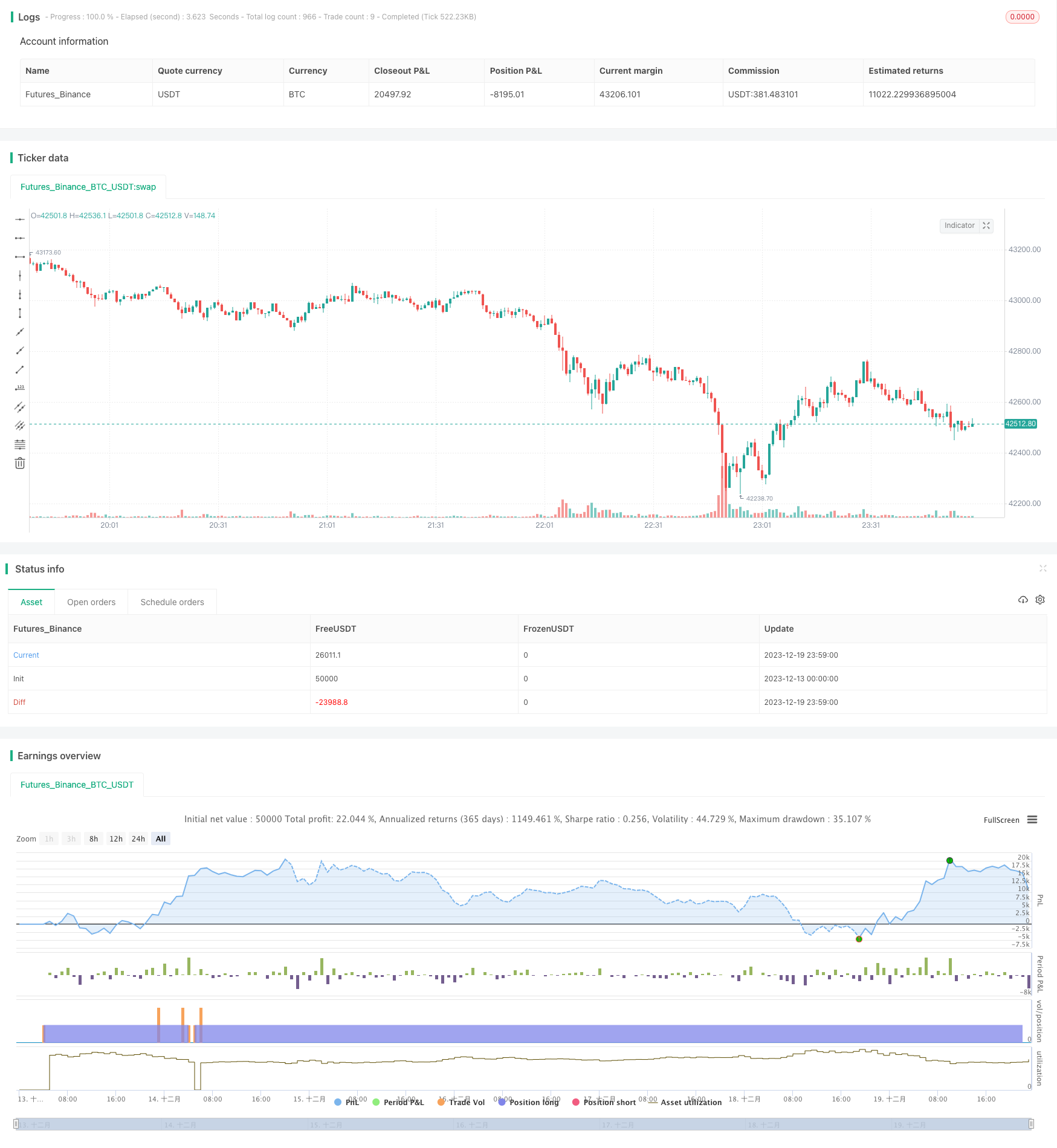
本策略命名为“均线回转反转策略”(Mean Reversion Reverse Strategy Based on Moving Average),其主要思想是在跌破关键均线后买入,并在达到预设目标利润后止盈。
该策略的主要原理是利用短期均线的回转,捕捉盘整行情中的反弹机会。具体来说,当价格跌破较长周期的均线(如20日线、50日线等)后表现出较强的超跌迹象,由于市场波动的 mean reversion 特性,价格往往会产生一定幅度的反弹。这时如果较短周期的均线(如10日线)出现向上回转的信号,那么就是一个比较好的买入时机。对应于本策略,就是当收盘价低于20日线而高于50日线时买入,利用短线回转,捕捉其反弹行情。
该策略的具体买入逻辑是:价格跌破20日线后买入1手,跌破50日线后加仓1手,跌破100日线后继续加仓1手,跌破200日线最多加仓1手,做多4手。在达到预设的止盈目标后平仓。同时设置了时间和止损条件。
优势分析
- 利用均线的回转特征,可以有效识别短期反弹机会
- 分批建仓,降低单一点位的风险
- 设置止盈条件,可以锁定盈利
- 利用开盘价和前低点进行过滤,避免假突破
风险分析
- 长期持有时,可能面临反转风险。如果行情继续下跌,则损失会进一步扩大
- 均线信号可能出现误报,从而导致亏损
- 设定的止盈目标可能达不到,无法全部或部分止盈
优化方向
- 可以测试不同参数设置下的收益率及稳定性
- 可以考虑结合其他指标如MACD、KD等来决定买入
- 可以根据不同品种特点选择适合其交易风格的均线周期
- 可以引入机器学习算法来动态优化参数
总结
本策略整体来说是比较经典和通用的均线交易策略。它正确运用了均线的smooting特性,同时结合多个均线来识别短期买入时机。通过分批建仓和及时止盈来控制风险。但其对市场突发事件如重大政策消息等的应对可能比较被动,这是可以继续优化的方向。总体而言,在参数优化和风控方面进行适当改进后,该策略可以获得稳定的超额收益。
策略源码
/*backtest
start: 2023-12-13 00:00:00
end: 2023-12-20 00:00:00
period: 1m
basePeriod: 1m
exchanges: [{"eid":"Futures_Binance","currency":"BTC_USDT"}]
*/
//@version=5
strategy("EMA_zorba1", shorttitle="zorba_ema", overlay=true)
// Input parameters
qt1 = input.int(5, title="Quantity 1", minval=1)
qt2 = input.int(10, title="Quantity 2", minval=1)
qt3 = input.int(15, title="Quantity 3", minval=1)
qt4 = input.int(20, title="Quantity 4", minval=1)
ema10 = ta.ema(close, 10)
ema20 = ta.ema(close, 20)
ema50 = ta.ema(close, 50)
ema100 = ta.ema(close, 100)
ema200 = ta.ema(close, 200)
// Date range filter
start_date = timestamp(year=2021, month=1, day=1)
end_date = timestamp(year=2024, month=10, day=27)
in_date_range = true
// Profit condition
profit_percentage = input(1, title="Profit Percentage") // Adjust this value as needed
// Pyramiding setting
pyramiding = input.int(2, title="Pyramiding", minval=1, maxval=10)
// Buy conditions
buy_condition_1 = in_date_range and close < ema20 and close > ema50 and close < open and close < low[1]
buy_condition_2 = in_date_range and close < ema50 and close > ema100 and close < open and close < low[1]
buy_condition_3 = in_date_range and close < ema100 and close > ema200 and close < open and close < low[1]
buy_condition_4 = in_date_range and close < ema200 and close < open and close < low[1]
// Exit conditions
profit_condition = strategy.position_avg_price * (1 + profit_percentage / 100) <= close
exit_condition_1 = in_date_range and (close > ema10 and ema10 > ema20 and ema10 > ema50 and ema10 > ema100 and ema10 > ema200 and close < open) and profit_condition and close < low[1] and close < low[2]
exit_condition_2 = in_date_range and (close < ema10 and close[1] > ema10 and close < close[1] and ema10 > ema20 and ema10 > ema50 and ema10 > ema100 and ema10 > ema200 and close < open) and profit_condition and close < low[1] and close < low[2]
// Exit condition for when today's close is less than the previous day's low
//exit_condition_3 = close < low[1]
// Strategy logic
strategy.entry("Buy1", strategy.long, qty=qt1 * pyramiding, when=buy_condition_1)
strategy.entry("Buy2", strategy.long, qty=qt2 * pyramiding, when=buy_condition_2)
strategy.entry("Buy3", strategy.long, qty=qt3 * pyramiding, when=buy_condition_3)
strategy.entry("Buy4", strategy.long, qty=qt4 * pyramiding, when=buy_condition_4)
strategy.close("Buy1", when=exit_condition_1 or exit_condition_2)
strategy.close("Buy2", when=exit_condition_1 or exit_condition_2)
strategy.close("Buy3", when=exit_condition_1 or exit_condition_2)
strategy.close("Buy4", when=exit_condition_1 or exit_condition_2)